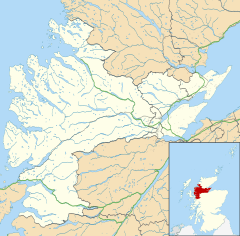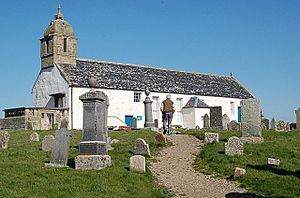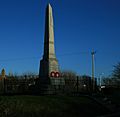Portmahomack facts for kids
Quick facts for kids Portmahomack
|
|
|---|---|
Portmahomack |
|
| OS grid reference | NH915948 |
| Civil parish |
|
| Council area | |
| Country | Scotland |
| Sovereign state | United Kingdom |
| Post town | Tain |
| Postcode district | IV20 |
| Police | Northern |
| Fire | Highlands and Islands |
| Ambulance | Scottish |
| EU Parliament | Scotland |
Portmahomack is a small fishing village in Easter Ross, Scotland. Its name comes from the Scottish Gaelic Port Mo Chalmaig, meaning 'Haven of My Saint Colmóc'.
The village is located on the Tarbat Peninsula. The Tarbat Ness Lighthouse is about three miles (5 km) away. You can also find Ballone Castle about one mile (1.5 km) from the village.
Portmahomack sits on a sandy bay with a small harbour. This harbour was designed by a famous engineer named Thomas Telford. It's special because it's on the east coast of Scotland but faces west! This is quite rare.
The area is known for its history. People have lived here for a very long time. It was important during the time of the Picts, early Christians, and the Vikings. Today, Portmahomack is inside the Moray Firth Special Area of Conservation. This means it's a great place for watching dolphins and whales.
The village has a primary school and a golf course. You can also find a hotel, places to eat, and a shop with a post office. The closest train station is at Fearn railway station. For flying, the nearest airport is Inverness Airport. The town of Tain is about 10 miles (16 km) west. Tain offers more services and also has a train station. The small village of Rockfield is nearby.
Contents
A Glimpse into Portmahomack's Past
Portmahomack has a long and interesting history. It is located about nine miles (14 km) east of Tain. People have lived here for thousands of years.
The earliest signs of people living here are from shell middens. These are ancient piles of shells. They show that people were here as early as 1,000 or 2,000 years BCE.
You can also find the remains of an Iron Age broch near the village. A broch is an ancient stone tower.
Ancient Church Discoveries
For a long time, people thought Portmahomack was home to an important early church. This was because of old Christian carved stones found here. These stones date back to the 8th and 9th centuries.
Was There a Roman Camp?
In 1822, a minister described a "beautiful square fortification" nearby. Later, an archaeologist named O. G. S. Crawford wondered if it might have been a Roman camp. However, no Roman settlement has been found there since.
The Pictish Monastery
Portmahomack is famous for being the site of the first confirmed Pictish monastery. The Picts were an ancient people who lived in Scotland. Between 1994 and 2007, a big archaeological dig took place here. It was led by Martin Carver.
Archaeologists found many things around the old St Colman's church. They uncovered an old ditch, a burial ground, and parts of a stone church. They also found many carved stone pieces in the Pictish style.
The monastery started around 550 AD. It was destroyed by fire around 800 AD. It had a burial ground and a stone church. There were also workshops where people made church items and early Christian books. This was the first time experts found evidence of vellum (a type of parchment) being made at such an old site.
More than 200 pieces of carved stone have been found. Many were broken, suggesting the monastery was violently destroyed. This might have happened during a Viking raid around 800 AD.
The old church building has been restored. It now houses a museum. The oldest part of the building might be from the 9th century. The Tarbat Historic Trust manages the museum and visitor centre.
Recent studies of the ancient ditch around the monastery found old plant samples. These samples date from 140 AD to 590 AD. The area inside the ditch might have been a settlement or a center for the Pictish community.
Local Battles and History
The Battle of Tarbat Ness
The Battle of Tarbat Ness was a land battle. It was fought around 1030–1040. It was between Thorfinn the Mighty, who was the Earl of Caithness, and the King of Scotland.
The Battle of Tarbat
In the 1480s, a group from the Clan Mackay were trapped in the Tarbat church. This happened during the Battle of Tarbat. The Clan Ross attacked them. Many were killed before the church was set on fire.
Fishing and Shipping History
In the 17th century, a lot of fish were caught here. These included cod, skate, ling, halibut, lobsters, and turbot. This continued until the late 18th century.
More than 100 ships used to export grain from the harbour. Herring fishing became very popular between 1850 and 1890. This brought more jobs and money to the area.
However, by the late 19th century, the herring industry declined. This was due to more steam trawlers and the building of the Balintore harbour nearby. Grain exports from Portmahomack ended in the 1930s.
Portmahomack Today: A Tourist Spot
Today, Portmahomack is a popular place for tourists. It has a traditional harbour and a beach for swimming. You can also play golf, watch dolphins, go fishing, and enjoy other water sports.
The village has about 500 to 600 people living there permanently. The old parish church is now the Tarbat Discovery Centre. This museum shows local history. It also displays many items found during the archaeological digs.
The museum also has the Peter Fraser Archive. This is a collection of items related to Peter Fraser. He was the wartime prime minister of New Zealand. He was born and grew up in Hill of Fearn, about seven miles (11 km) from Portmahomack.
Inside the museum, you can see many pieces of Pictish stone sculpture. These stones have amazing carvings. They show church figures, animals, and Celtic patterns. The church building itself is very old and interesting.
Some important Pictish carved stones from Portmahomack are in the Museum of Scotland in Edinburgh. You can see copies of them at the Tarbat Discovery Centre.
Two other important old buildings are the 'girnals' (storehouses). They were built in the late 17th century and 1779. They overlook the harbour and have been turned into homes. One of them is one of the oldest such buildings in Scotland. The village also has many attractive houses from the 18th and early 19th centuries along the shore.
Famous People from the Area
Portmahomack has been home to or visited by some notable people.
- John Reith, 1st Baron Reith, the first Director-General of the BBC, loved to holiday here. He stayed in a house on the seafront that is still painted blue.
- The writer Anne Perry lived near the village for several years.
- John Shepherd-Barron, who invented the ATM, lived nearby until he passed away in 2010.
- Professor Thomas Summers West was a famous scientist from the village. An exhibition was held in his name at the Tarbat Discovery Centre in 2011.
Gallery






